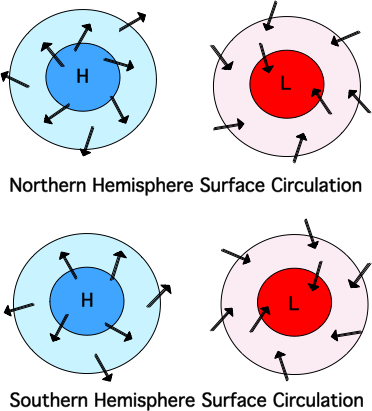Surface circulation around highs and lows.The combined effects of the pressure gradient, Coriolis effect, surface friction is shown in Figure 6.11. Recall that air always flows from higher towards lower pressure. Around high pressure systems (H), air is directed outward from the center. Around low pressure systems (L) air is directed inward toward the center. If pressure gradient was the only force acting on the air, wind would move directly across isobars at a perpedicular angle. Wind instead moves across the isobars at an angle of anywhere from 10o to 45o. Because the Coriolis Effect bends the air to the right of of it's path (i.e. the direction of the pressure gradient) in the Northern hemisphere, air takes on a clockwise flow around highs and counterclockwise around lows. In the Southern hemisphere, air circulates in a counterclockwise fashion around highs and clockwise around lows.
Figure 6.11 Surface Circulation Around High and Low Pressure Systems Above the "friction layer", only the pressure gradient and Coriolis effect operate on wind. At particular latitudes, the opposing pressure gradient and Coriolis forces can balance one another high in the troposphere above the friction layer. When this occurs, winds tend to blow parallel to isobars. Winds that blow roughly parallel to isobars are called "geostrophic winds". The fast-moving jet streams are type of geostrophic wind.
|
